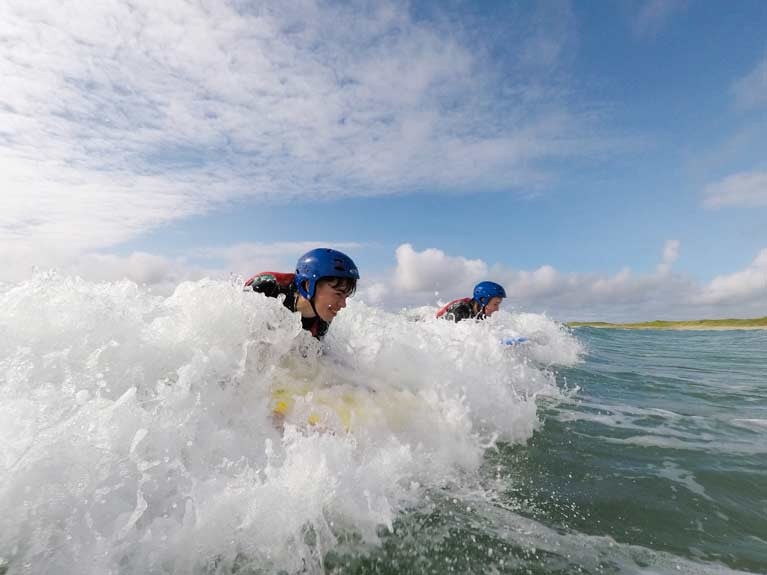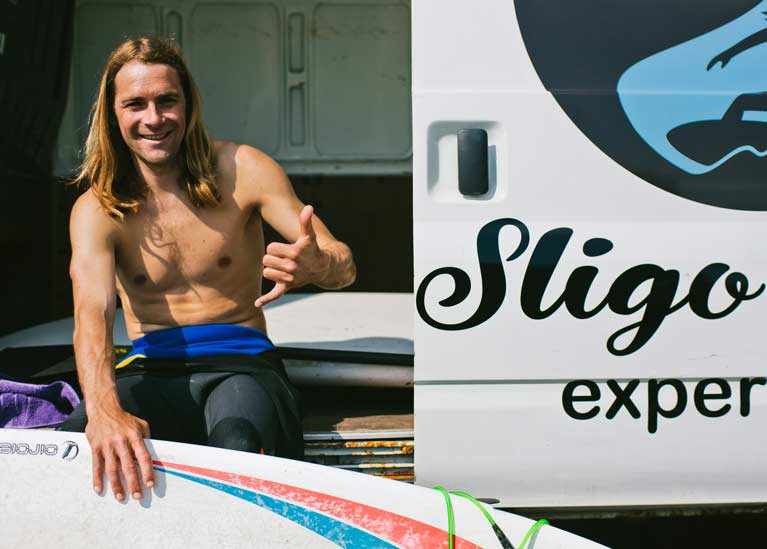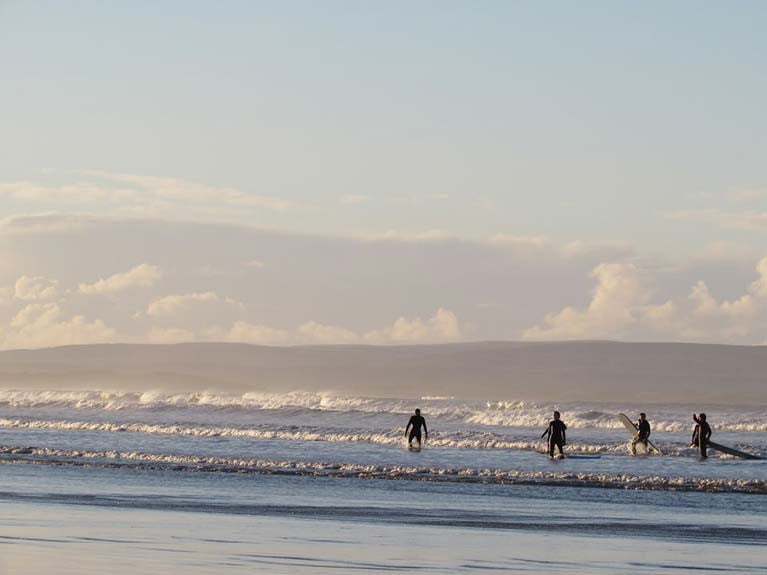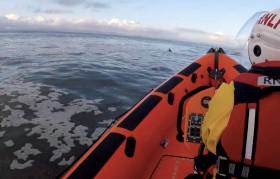Displaying items by tag: Surfing
Surfer Riding Massive Portuguese Wave Among Images in World Sports Photography Awards
A French surfer, Justine Dupont, was captured riding a wave during a surfing session at Praia do Norte in Nazare, Portugal.
This photo, taken by Octavio Passos of Getty Images, was selected as one of 24 winning images across various sports categories, including American Football, Basketball, Cycling, Gymnastics, and Football. Over 700 professional sports photographers from more than 70 countries submitted their images this year.
The World Sports Photography Awards celebrate and recognize incredible sports images and the photographers who capture them, telling compelling stories of the emotion, passion, athleticism, and focus at the heart of sport.
These awards are the only global recognition given to sports photography. For more images, please visit the World Sports Photography Awards here
The new national surf centre in Sligo’s Strandhill aims to attract over 40,000 visitors annually by 2028, two Government ministers have predicted.
This may rise to over 50,000 visitors annually by 2033, according to Minister for Tourism and Sport Catherine Martin and Minister for Rural and Community Development Heather Humphreys.
“Fáilte Ireland anticipates the visitors attracted to the National Surf Centre, Strandhill will generate revenue exceeding €34million in the Sligo region by 2033, creating new economic opportunities for local communities and indirectly supporting 21 jobs annually,” Ms Martin said.
 The new National Surf Centre at Strandhill in County Sligo Photo: Barry Cronin
The new National Surf Centre at Strandhill in County Sligo Photo: Barry Cronin
Ms Humphreys said she was pleased that her department was able to support the surf centre with an investment of over €1.1 million under the Rural Regeneration and Development Fund.
Orla Carroll, Director of Product Development at Fáilte Ireland, said the centre developed by her organisation in partnership with Sligo County Council and the Department of Rural Community Development, is a “major new activity tourism amenity”.
“ The new centre delivers on Fáilte Ireland’s “Opening the Outdoors” strategic pillar, supporting our ambition to develop Ireland as an internationally recognised outdoor activity destination,” she said.
Home to three surf schools and the County Sligo Surf Club, the centre will offer a “vast and inclusive programme of services to suit every surfer, from novice to experienced”.
The centre features artwork on the front exterior by Donegal artist and surfer, Barry Britton.
The centre’s funding breakdown is as follows:
 National Surfing Centre’s funding breakdown
National Surfing Centre’s funding breakdown
Australian Breaks World Surfing Record
An Australian has set a new world record for the longest surfing session.
Blake Johnston (40) broke the existing record when he spent 30 hours and 11 minutes on the water off south Sydney’s Cronulla beach.
As BBC News reports, Johnston had ridden over 600 waves when he was given a quick medical check-up and eye drops at lunchtime on Friday.
He had recorded 40 hours on the board, surfing 700 waves, when he finished.
The former professional surfer and distance runner risked jellyfish stings, possible shark attack, sleep deprivation, hypothermia in his attempt.
Possible blindness, ear infections and dehydration were also factors he had to take into consideration when making the attempt.
Sydney surfer, Blake Johnston was back at Cronulla beach today, less than 24 hours after making global headlines for his remarkable 40 hour surf record. @WesternWilson9 #9News pic.twitter.com/GMezZj63Jc
— 9News Sydney (@9NewsSyd) March 18, 2023
He told journalists he was “pretty cooked” when he continued to surf after breaking the world record.
He has raised 240,000 Australian dollars (151,000 euro) for the Chumpy Pullin Foundation, established in memory of Australian Olympic snowboarder Alex “Chumpy” Pullin who drowned off the Australian Gold Coast after he set out spearfishing in 2020.
Monies he had raised will also go to mental health charities, partly in tribute to his father who took his own life a decade ago.
Read more on BBC News here
New Surfing Exhibition Makes Waves at Ulster Transport Museum
National Museum NI’s Ulster Transport Museum has introduced a new exhibition exploring the origins of surfing as a sport in Ireland. ‘Celtic Wave’ dives into this island’s connection to surfing and how this began in the 1960s through a group of determined men and women.
Celtic Wave includes exclusive films and interviews with some of the most talented surfers and shapers from the Irish surf scene such as Al Mennie, Andrew Hill and Gemma Gillespie as they share their stories and their passion for the sport. Other objects related to surfing featured in the exhibition include examples of sustainable approaches to surf clothing, surfboards designed by local shapers, posters created by legendary surfer Barry Britton and a 1970 Morris Traveller car, which has become symbolic of surfing in its heyday
Northern Ireland has become an increasingly popular surfing destination due to its wild Atlantic coast, which is exposed to waves originating in the North Atlantic. Numerous beaches and reefs across the island, including Portrush, Rossnowlagh and Tramore serve as popular surf spots and are home to many surf shops, schools and clubs which play an important role in supporting local tourism and communities.
Ulster Transport Museum tells the story of innovation and social change in this part of the world over decades across land, sea and sky, and Celtic Wave reinforces that connection to the sea by championing the local innovators and growing sub-community of surf enthusiasts through the range of objects in the exhibition while also driving home a sustainability mission with elements of the exhibition build made from recycled and sustainable materials.
Clare Ablett, Curator of History at National Museums NI, said: “We’re thrilled to announce the launch of our new Celtic Wave exhibition. The surfing community across the island is a vibrant movement and at Ulster Transport Museum their story has been largely untold, until now. Celtic Wave represents the people and passion that catapulted the popularity of surfing here, from the early pioneers in the 1960s up to the present day - and that’s why it has a place at the Ulster Transport Museum.
“The exhibition, which has been specially curated in collaboration with the surfing community, features 11 original objects that now have a place in the National Museums NI collection, including locally made surfboards from Larne, Coleraine and Portrush and video interviews from some of the biggest names in Irish surfing who have devoted their life to it.”
The first new exhibition at Ulster Transport Museum in over a year, Celtic Wave features iconic surfboards such as a replica of the 11’3” gun surfboard used by local big wave surfer, Portrush man Al Mennie, to surf monster waves on the west coast of Ireland. The original was created by Derry-Londonderry-based Rosy Surfboards, who made the replica for Celtic Wave.
Items also include men’s and women’s rash vests created by OceanR in County Cork, designed for extra warmth the polyester in the sustainable vests is made from recycled plastic water bottles which are cleaned and shredded before being transformed into clothing fibres, and the Gecko helmet worn by Al Mennie during a serious wipeout whilst surfing at Mullaghmore Head, Co. Sligo.
Speaking at the opening of the exhibition, Al Mennie said: “It’s been a great honour to work with the Ulster Transport Museum to bring Celtic Wave to life. The exhibition captures surfing in its many eras to date and acknowledges some the most influential characters in surfing from across the island.
“The surfing community has a really rich history and Celtic Wave is all about the people who have shaped this and their passion for the sport. There really is something for everyone to experience and learn about including a personal favourite feature – a simulator where visitors can sit on a jet-ski and tow me onto a big wave off the west coast of Ireland at St John’s Point.”
In encouraging sustainable choices and protecting our local waters, visitors to Celtic Wave on September 24, in partnership with Experience Ards and North Down, can book an on the water experience on Belfast Lough, accessible from the Ulster Transport Museum site, to take part in paddleboarding and water litter pick.
Admission to Celtic Wave is included in general admission to the museum. For more information visit nmni.com
Appeal to Surfers to Participate in "Paddle-Out" for Sligo Community Mental Health Project
Surfers have been invited to help set a new Irish “paddle out” record next month while raising funds for a community mental health project in Sligo.
The first “Big Board Meeting”, as it is called, is set for September 17th, when surfers will paddle out from Rosses Point beach outside Sligo town and form a circle.
Surfers of all abilities can participate, for an entry fee of 20 euros, and organisers hope to draw a number that can rival the 500 surfers who took part in a similar “paddle out” at Huntington beach, California in 2017.
The circle ritual has been held in the past as a mark of respect following the death of a surfer. However, in this case, the plan is to set an Irish record for the largest circle of surfers formed at sea, and to generate set-up costs for a new volunteer-led facility spearheaded by community mental health initiative Flourish.
Flourish, which is based on Clarion Road, Ballytivnan, Co Sligo, says it aims to create a bridge between voluntary community organisations and statutory services such as the HSE Primary Care and Mental Health/Health and Wellbeing supports.
It says that Ballytivnan has “long been associated with psychiatric care”, and the nearby Clarion Hotel was previously St Columba’s Hospital, Sligo’s psychiatric hospital, until it closed in 1992.
Part of the lands were used to farm the food for the hospital, and provided “therapeutic horticulture” to those who availed of the services. Flourish says it plans a revamped garden, along with a premises including a café, kitchen and “safe and welcoming spaces” to access supports.
Flourish representative Hugh Myles explains that “as we’re an organisation based in Sligo, a county synonymous with surfing and the great outdoors, the ritual of surfers paddling out and joining hands seemed a particularly poignant way to remember those who have tragically died as a result of suicide across the north west”.
“This facility will be the first of its type in Ireland, one for people who need to feel comfortable to talk. The café and gardens are designed to serve as an ice-breaker for people in crisis, while our training centre will help supply up to 300 volunteers with training in active listening. Eventually, the facility will be open 24/7, providing a round-the-clock refuge to those in need,”he says.
To register or donate click here
Fourish has also established a GoFundMe page here
Perfecting Surfboard "Pop-Ups" - Coláiste Uisce Goes Online
How to improve surfing with “pop-up” training is one of a number of “online” activities that a north Mayo Gaeltacht outdoor pursuits centre is offering to students this summer, The Irish Independent reports.
Coláiste Uisce, which teaches surfing, sailing, windsurfing and kayaking courses through the medium of the Irish language, had just spent some €0.5 million preparing for this season when the Covid-19 pandemic hit.
It is one of a number of Gaeltacht colleges which had to cancel residential courses this summer.
It has opted to offer a “virtual” Gaeltacht experience to students Juggling skills, environmental awareness walks and other task-based lessons through Irish form the core of “Blas Choláiste Uisce” which the college is now taking bookings for.
The five one-hour interactive online sessions culminate in a virtual céilí mór which students can participate in at home with their instructors.
The centre founded over 25 years ago by former Air Corps pilot Ciarán Ó Murchú and his wife Máire has taught courses to over 20,000 students and employs up to 17 full-time staff throughout the year.
Read more on The Irish Independent report here
Surfing schools have appealed to the Government to extend the Covid-19 wage subsidy scheme to their sector, as surfers return to the water.
They have also called on Minister for Tourism Shane Ross to lower the VAT rate for surf schools to ensure the sector can survive.
A statement issued by the Irish Surf School COVID Safety Working Group says it is “delighted to be able to open again with safety, as usual, the number one priority”.
Surf schools are required to submit detailed Covid-19 safety plans to the representative body, Irish Surfing, before re-opening, the statement says.
Safety measures include:
- Online bookings and payments
- Small group sizes (maximum of eight people from June 8)
- Travel restrictions (customers must travel no more 20 km from June 8)
- Two-metre social distancing for groups on land and in the water
- Hand and equipment sanitation must be observed
“Surfing is proven to improve mental health and boost well being,” the group says, and “after a gruelling two-month lockdown, more people than ever are hoping to relieve some stress and boredom by returning to the waves”.
 Learning to surf
Learning to surf
“Surf schools are now an important part of the prime offering of most of the most popular Irish seaside resorts,” the group says, with “hotspots” like Bundoran, Strandhill, Lahinch and Tramore drawing surfers from around the world.
“Surfing is not a niche sport in Ireland any longer. Surfing is now a mainstream recreational activity, which should come as no surprise to an Atlantic island nation that is now world-famous as a cold water surfing paradise,” it says.
The working group warns that some surf schools will not open until travel restrictions are relaxed again in July, and notes the majority of surf school owners cannot access the wage subsidy scheme for their employees.
“For many, this is going to delay reopening for some meaning their 2020 season will only be four or five weeks long,” the group says.
The working group says it is liaising with Sport Ireland, Irish Surfing and the Irish Association for Adventure Tourism to plan for the survival and recovery of the surf school industry.
However, it is seeking an extension of the wage subsidy and lowering of the VAT rate from 23 per cent. It notes that the rate is currently nine per cent in the Netherlands.
Irish Association of Adventure Tourism (IAAT) Brendan Kenny said that his group was “delighted to see that surf schools are re-opening, and we believe that the activities sector can lead the recovery of the Irish tourism industry”.
“Now more than ever, our country needs the physical and mental health benefits that activities deliver, so we'd encourage everyone to consider what experiences are available to them within the current public health guidelines,” Mr. Kenny said.
“There are however considerable obstacles for our sector including seasonal staff not benefiting from the wage subsidy scheme. We would urge the Government to deliver clarity on this issue which threatens businesses in our sector - none more so than the surf schools,” he said.
In relation to the VAT rate, the Irish surf school working group has appealed for its sector to be viewed as tourism, rather than sports business, and have the rate reviewed.
Irish Surfing development officer, Zoe Lally noted that a “surge” of people to beaches over the June bank holiday weekend had resulted in beaches and car parks being closed.
She said that some local authorities are “reluctant to authorise surf schools to reopen.”
“I would reiterate the importance of schools operating responsibly. Guidance from local authorities must be adhered to. It is particularly important that people are not enticed to travel past the 20-kilometre distance to surf and that surfing is not responsible for generating a surge in activity and crowds,” Ms. Lally said.
Surf Intervarsities Returns to Mayo - the "Adventure Capital of Ireland"
Top student surfers will gather in Mayo in early March for the Surf Intervarsities 2020 when hosts Galway-Mayo Institute of TechnologyI(GMIT) hope to secure a “three in a row” national title writes Lorna Siggins
Up to 200 surfers are expected to participate in the annual weekend of surfing on Achill island from March 6th to 8th.
The 20x20 Women in Sport campaign entitled ‘If she can’t see it, she can’t be it’ will be central to the weekend’s events.
GMIT Mayo Clubs and Societies’ Officer Sophie Devereux says “we are delighted to be part of this campaign”.
“We have reached out to surfers from around the globe and will use the Intervarsities to continue to spread this vital message,” she says.
GMIT Mayo has won the last two national championships in 2018 and 2019 and hopes to seize the title again this year.
Nigel Jennings, GMIT Mayo Sports Officer, says the 2020 Surf Intervarsities will “further enhance GMIT Mayo’s reputation as a national power in the realm of outdoor adventure activities and reinforce Mayo’s growing reputation as the destination of choice for outdoor adventure activities”.
Prof Neville McClenaghan, GMIT Mayo campus vice-president, said it would highlight the skills of Mayo campus students studying the Bachelor of Arts and Bachelor of Arts Honours Outdoor Education and other programmes.
He said it was also a “great opportunity for talented surfers from colleges across the land to come and demonstrate their talents here in Mayo, the adventure capital of Ireland”.
Bundoran Lifeboat Helps Surfer Safely To Shore
#Lifeboats - Bundoran’s RNLI crew assisted a surfer safely to shore on Saturday afternoon (10 November).
The volunteers launched after a member of the public raised the alarm, having spotted someone they thought to be in difficulty and waving their arm off Rougey Point in Bundoran.
The Irish Coast Guard requested the inshore lifeboat to launch at 3.28pm and 10 minutes later the lifeboat, helmed by Killian O’Kelly, was at sea.
Weather conditions at the time were blowing a light south-easterly wind and there was a three-metre swell.
Once on scene, the lifeboat crew observed that the surfer, while not in difficulty or in any immediate danger, was in a challenging part of the sea and some distance away from the shore.
The crew made the decision to take the teenager onboard and transport him safely back to Bundoran Lifeboat Station.
Speaking following the callout, O’Kelly said: “We would like to commend the member of the public who raised the alarm this afternoon — that is always the right thing to do if you see someone you think or know to be in difficulty.
“While this surfer was not in any immediate danger, he was some distance from shore so we made a call to assist him safely back to shore.”
Elsewhere, a person who went missing while kitesurfing off Ballybunion in Co Clare yesterday evening (Sunday 11 November) was found on land several hours later, as RTÉ News reports.
The kitesurfer, who had come ashore at Kilkee, was said to be suffering the effects of cold after spending as much as two-and-a-half hours at sea and was taken to hospital.
#Rescue - A surfer was rescued from the sea off Northern Ireland yesterday evening (Monday 1 May) after more than 30 hours in the water.
Belfast Coastguard co-ordinated the search for the missing man who had gone surfing near Campbeltown in Argyll, Western Scoland on Sunday and failed to return.
A large area of sea and shoreline was searched from lunchtime on Monday when the alarm was raised, involving RNLI lifeboats from Campbeltown and Islay in Scotland and Red Bay in Co Antrim, as well as coastguard rescue teams from Campbeltown, Southend, Gigha, Tarbert and Port Ellen, and HM Coastguard’s rescue helicopter based at Prestwick.
Dawn Petrie at Belfast Coastguard Operations Centre, who was co-ordinating the search, said: “Hope was fading of finding the surfer safe and well after such a long period in the water and with nightfall approaching we were gravely concerned.
“But at 7.30pm tonight, the crew on the coastguard rescue helicopter were delighted when they located the man still with his surfboard and 13 miles off the coast.
“He was kitted out with all the right clothing including a thick neoprene suit and this must have helped him to survive for so long at sea. He is hypothermic but conscious and has been flown to hospital in Belfast.”
HM Coastguard reminds all coastal users this summer to be prepared before you go out on the water or at the coast where conditions can change quickly. Tell someone where you are going and take an appropriate means of raising the alarm in an emergency.
RNLI Add:
A Northern Ireland lifeboat was involved in the huge search and rescue operation for a missing surfer who left a Scottish beach on Sunday morning and spent 32 hours at sea before being found last night (Monday 1 May). Red Bay RNLI were requested to launch by Belfast coastguard to join with the Scottish lifeboats, Campbeltown and Islay, along with rescue teams from Campbeltown, Southend, Gigha, Tarbert and Port Ellen and the Coastguard rescue helicopter based at Prestwick. The man was eventually located by the coastguard helicopter and transferred to hospital.
The young man had set off to go surfing off the Argyll coast on Sunday morning and had not been heard from since 11.30am. In a huge search operation RNLI lifeboats were launched on both sides of the Irish Sea with Scottish and Irish lifeboats searching the extensive body of water for the missing man.
At 7.30pm the missing surfer was located by the coastguard helicopter and was still with his surfboard 13 miles off the coast.
Commenting on the search and rescue operation Red Bay RNLI Coxswain Paddy McLaughlin said, ‘This was a huge search and rescue operation. To have lifeboats launched from both Scotland and Ireland shows the incredible effort that went into the search. Our lifeboat crews along with our colleagues in the coastguard undertook an extensive and detailed search in the large area between the two coasts and thankfully this resulted in a successful outcome.’
‘The young man wore the correct clothing and stayed with his surfboard, giving himself valuable time and keeping safe. It just shows that even after 32 hours at sea people can be found and rescued. We wish the young man a full recovery after his ordeal.’



































































